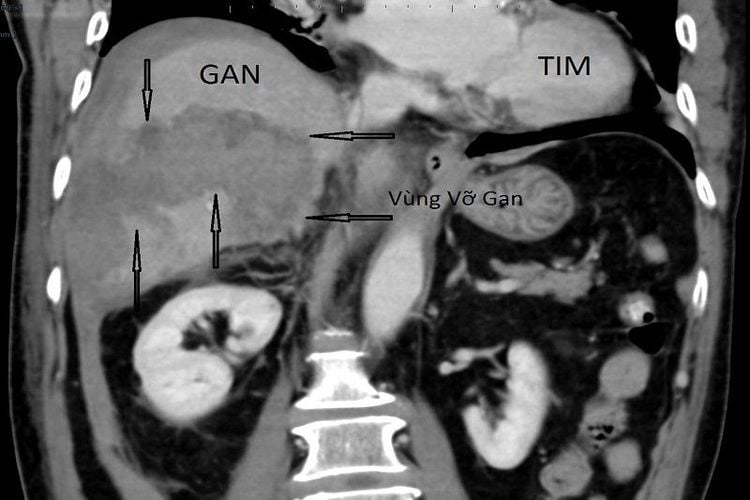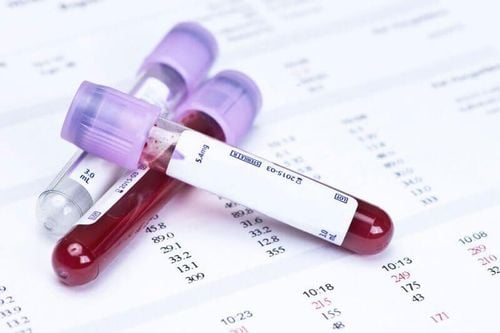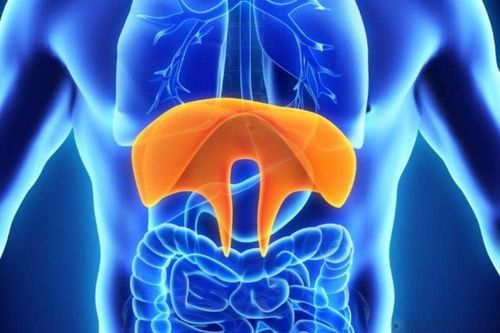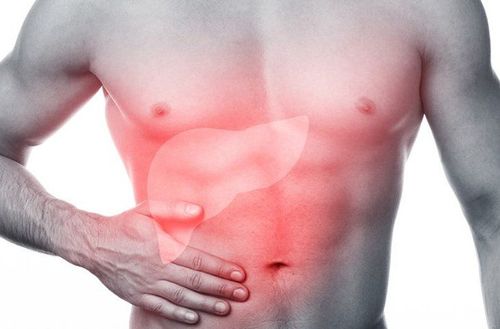This is an automatically translated article.
Liver is a solid organ with a large volume in the human body, in closed abdominal trauma, liver rupture accounts for nearly 68%. Liver rupture has many different levels if not detected in time, leading to abdominal bleeding, causing shock to the patient due to blood loss and easily leading to death.
1. Signs of liver rupture in blunt abdominal trauma
Closed abdominal trauma is the injury to the abdomen, mainly solid visceral trauma causing acute bleeding, hollow visceral trauma causing peritonitis. Sometimes closed abdominal trauma causes combined injuries of both organs, or injuries to other organs such as brain, lungs, bones...
Closed abdominal trauma with causes mainly caused by accidents such as: : Traffic accidents, labor accidents, accidents in daily life, accidents in sports. Another part of the cause is due to a fight that causes abdominal injuries.
Here are some signs of liver rupture in blunt abdominal trauma
Pain when pressing on the right rib, pain spreading above the shoulder, the right half of the abdomen reacts when pressed, the abdomen gradually distended. signs of bruising, scratches on the right abdomen, chest, possibly broken ribs 8, 9, 10 in the right rib arch If the patient has severe liver rupture, there will be signs of shock due to trauma such as skin, mucous membranes, and skin. pale skin, possible fainting or fainting, pulse is difficult to catch, fast and small, nausea, bowel obstruction From the above signs, the patient should go to the hospital as soon as possible to do tests such as laboratory tests. blood, x-ray, abdominal CT scan, laparoscopy to check for damage. Avoid leaving the damage too long leading to not being treated in time.
2. Classification of liver rupture levels in blunt abdominal trauma

Hình ảnh chụp CT vùng vỡ gan
According to the American Association of Trauma Surgery (AAST) in 1994, liver rupture is divided into 6 grades including:
Grade 1 rupture: Subcapsular hematoma less than 10% of the surface area, damage to the parenchyma Tissue depth less than 1cm Grade 2 liver rupture: Subcapsular hematoma from 10%-50% of surface area, parenchymal damage 1-3 cm deep, length less than 10cm Grade 3 rupture: Larger subcapsular hematoma 50% of surface area, intraparenchymal hematoma larger than 10cm, deeper than 3cm, broken hematoma Grade 4: Parenchymal injury, 25-75% rupture of liver lobe, rupture 1- 3 Couinaud's lobes in one lobe of liver Grade 5: Parenchymal damage, more than 75% of the lobe rupture, more than 3 Couinauds in one lobe, damage to the main blood vessel of the liver or to nearby blood vessels Grade 6 liver rupture: The liver is completely crushed
3. Treatment of liver rupture in blunt abdominal trauma

xét nghiệm Hematocrit để điều trị vỡ gan trong chấn thương bụng kín
The liver is an important organ in the human body, especially the liver contains a lot of blood vessels. If the liver is ruptured, it is easy to lose blood quickly, so it needs to be treated promptly to avoid long-term danger to the patient's life.
Treatment of liver rupture includes medical treatment and surgical treatment
3.1 Medical treatment For lesions from grade 1 to 5 and the patient's condition is stable. Patients with grade 3 to 5 liver rupture are kept in the intensive care unit for hourly vitals until they return to normal.
Test Hematocrit (Hct) every 6 hours for 1 to 2 days. After the Htc level is stable, continue to monitor and can be discharged after about 5 days of treatment. The patient continued to monitor at home for a week and re-examined if there were more painful manifestations, jaundice.
3.2 Surgical treatment Usually with grade 6 liver damage, or other grade liver damage where the patient is in an unstable condition, there is too much fluid in the abdomen, the abdomen is still very painful and distended or the patient There are associated lesions requiring surgery.
Principles of surgical management include: Control bleeding, remove lifeless parts of the liver, treat damaged blood vessels, biliary tract and treat other combined injuries.
In addition, many hospitals now use less invasive liver rupture therapy by vascular embolization, using this method to help patients stop bleeding immediately, very safely and effectively. This approach helps patients avoid surgery, avoids endotracheal anesthesia, and reduces the amount of blood that needs to be transfused.
Vinmec International General Hospital gathers a team of qualified and skilled medical doctors from all over the country and abroad; The equipment system is focused on investment, meeting international standards, thus ensuring the best possible surgery.
Customers who need to visit and consult about laparoscopic surgery at Vinmec, please book an appointment on the website for the best service.
Please dial HOTLINE for more information or register for an appointment HERE. Download MyVinmec app to make appointments faster and to manage your bookings easily.











